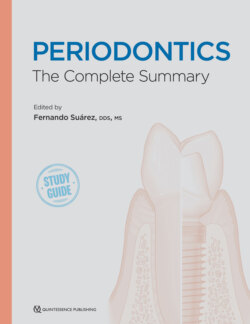Читать книгу Periodontics - Fernando Suarez - Страница 86
На сайте Литреса книга снята с продажи.
5 LOCAL ANATOMICAL AND CONTRIBUTING FACTORS Carlos Garaicoa-Pazmiño, DDS, MS Vahid Khoshkam, DDS, MS DEFINITIONS AND TERMINOLOGY
ОглавлениеBiofilm: A multispecies community of microorganisms that adhere to each other and a surface and are encased in an extracellular matrix. The extracellular matrix is a complex polymeric substance that protects the microorganisms from environmental stresses. Bacteria living in a biofilm have a different physiology from free-living bacteria and are more difficult to eradicate with antibiotics. Dental plaque is the prototypical example of a biofilm.1
Calculus: A hard concretion that forms on teeth or dental prostheses through calcification of microbial plaque.1
Subgingival calculus: Calculus formed apical to the gingival margin, often brown or black, hard and tenacious. Also known as seruminal calculus.1
Supragingival calculus: Calculus formed coronal to the gingival margin, usually formed more recently than subgingival calculus. Also known as salivary calculus.1
Cemental tears: A specific type of root surface fracture and characterized by the detachment of a cemental fragment.2
Cementicles: Calcified spherical bodies (0.2 to 0.3 mm) composed of cementum lying free within the periodontal ligament, attached to the cementum, or embedded within it.1,3–6
Crowding: Discrepancy between tooth sizes and arch length and/or tooth positioning that results in malalignment and abnormal contact relationships between teeth.1
Enamel pearl: A focal mass of enamel that has formed apical to the cementoenamel junction (CEJ) and is typically located in the areas between the roots of molars.1
Enamel projection: An apical extension of enamel, usually toward a furcation.1 May prevent true attachment of periodontal ligament fibers upon the root surface.7
Exostosis: A benign bone growth projection outward from the surface of a bone.1
Furcation: Anatomical area of a multirooted tooth where the roots diverge.1
Furcation arrow: A radiographic shadow associated with a proximal furcation.8
Furcation entrance: Transitional area between the undivided and the divided part of the root.9
Furcation fornix: Roof of the furcation.9
Furcation involvement (invasion): Pathologic resorption of bone within the furcation. The extension of periodontitis or pulpitis into a trifurcation area.1
Impacted tooth (impaction): An unerupted or partially erupted tooth so positioned that complete eruption is unlikely.1
Intermediate bifurcational ridge (IBR): A distinct ridge running across the bifurcation in a mesiodistal direction.10
Overhang: Excess of dental restorative material extending beyond cavity margins.1
Palatal groove: A developmental, anomalous groove usually found on the palatal aspect of maxillary central and lateral incisors.1
Plunger cusp: An active passage of food into the embrasure area during function.11
Plaque: An organized mass, consisting mainly of microorganisms embedded in a matrix of glycopolymers, that adheres to teeth, prostheses, and oral surfaces and is found in the gingival crevice and periodontal pockets. Other components include an organic, polysaccharide-protein matrix consisting of bacterial by-products such as enzymes, food debris, desquamated cells, and inorganic components such as calcium and phosphate.1
Root complex: Portion of a tooth apical to the CEJ.9
Root concavity: Developmental depressions as cratered, valley-like shapes in the root surface.12
Root cone: Divided region of the root complex.9
Root proximity: Closeness of roots of adjacent teeth typically associated with inadequate interdental tissue.1
Root surface area: Area available for periodontal attachment.13
Root trunk: Undivided region of the root between the CEJ and furcation.9
The anatomy of the dentition differs significantly based on multiple factors, including but not limited to tooth type, number of roots, location of the furcation entrance, root trunk length, total root length, and root divergence/convergence. In addition, different local characteristics may alter or influence these anatomical variations. A comprehensive understanding of the tooth morphology and tooth-related factors that may influence or predispose periodontal breakdown is paramount for an accurate diagnosis and treatment plan. This chapter includes a comprehensive description of the evidence on the role of these factors in periodontal diseases.
